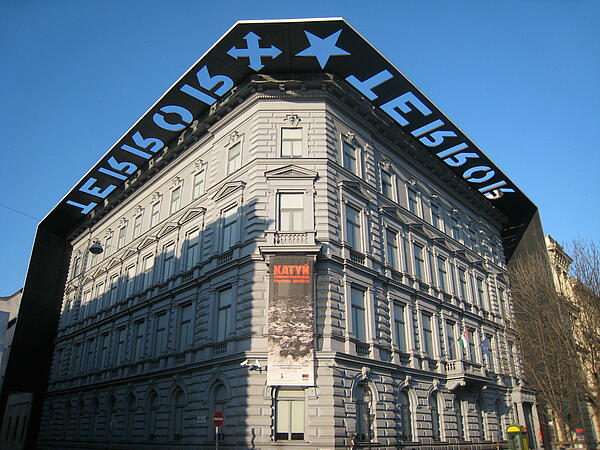Hungarian Secret Police
After the end of World War Two, communism was imposed on Hungary by Soviet Russia. Communist Hungary became the home of a notorious secret police force.The force’s brutality was one of the main causes behind the 1956 Hungarian Uprising. The secret police created created a climate of fear which spilled into outright rebellion in November 1956.
The force was initially called ÁVO (the Hungarian State Police State Protection Department, Magyar Államrendőrség Államvédelmi Osztálya). WIthin a few years it had become ÁVH (the State Protection Authority, Államvédelmi Hatóság), but the name ÁVO stuck and continues to be used.
The headquarters of the ÁVO was 60 Andrássy Avenue in Budapest, the capital of Hungary. During the Nazi occupation of Hungary in World War Two the building was the HQ for the Hungarian Nazi Arrow Cross movement, meaning it was already equipped with torture chambers. This address is now ‘The House of Terror’, dedicated to the victims of the fascist and communist regimes in twentieth-century Hungary.

After the end of World War Two, Soviet rule was quickly imposed upon Hungary.The Soviets held Eastern Europe’s only free election in Hungary in November 1945. The Hungarian Communist Party won only 17 per cent of the votes. The Smallholders’ Party won 57 per cent of the vote: a clear majority. However, the centre-right Party was pressurized into forming a coalition in which Communists held several important positions. For example, the leader of the Communist party, Mátyás Rákosi, was given the post of deputy Prime Minister. The Communist László Rajk was made minister of the interior. In this post, he was able to create the Hungarian security police force (ÁVO). Gradually, the Smallholders’ Party were forced out of politics. Several leaders of the Party were arrested in 1947. By 1950 the Communists ruled Hungary and any pretense of democracy had been dropped.
The role of the ÁVO was out opponents to the Communist regime. Its first leader was a Hungarian called Gábor Péter. Péter took a hardline approach on suspected traitors and he was prepared to use torture to find ‘evidence’ of wrong-doing.
The Hungarian Communists still only gained 22 per cent of the vote in the 1947 election, dispute a widespread electoral fraud: approximately 50,000 fraudulent votes were counted for the Communists. This electoral failure probably spurred on Péter to clamp down even harder on opposition to the regime in order to make sure the communists maintained its supremacy in the country.
The treatment of László Rajk, the man who set up the ÁVO as minister of interior and therefore Gábor Péter’s boss, shows the viciousness of the Hungarian secret police. Rajk was accused of plotting with Marshall Tito to overthrow the Hungarian Communist government, which had been imposed on Hungary in January 1948. But the secret police arrested Rajk on 30 May 1948 and brutally tortured him to try and extract a confession from him. Péter threatened to involve Rajk’s family if he did not confess.
Rajk held out until 11 June – twelve days after his arrest – when he confessed to try and save his family.Rajk was tried in a show trial between 16 and 24 September 1949, where he received a death sentence. He was executed on 15 October 1949. The Soviet MGB (the Soviet Intelligence Agency from 1946 to 1953) was probably also involved in his downfall.
The Hungarian secret police were hugely feared. In 1951, when the new Minister of the Interior, Sándor Zöld, discovered that he was about to be purged by the Hungarian Communist Party, he killed himself and his close family.
In such a climate of suspicion, even Péter faced suspicion and accusations, including the accusations plotting the murder of Stalin and other leaders in the Hungarian Communist Party. After Péter was arrested and threatened with torture, he confessed that he was “an agent of the British and Zionist Intelligence agencies”. Péter avoided execution and was sent to prison. He was released in 1959 and given a position on the lower rungs of government.
After the death of Stalin in 1953, there was some hope that the situation in Hungary would change. However, the .ÁVO (now called the ÁVH) was still hated. This hatred spilled over during the Hungarian Uprising in October-November 1956. The uprising saw the arrest and execution of members of the ÁVH, who were then publicly hanged from lampposts with money stuffed into their mouths. On 29 October Imre Nagy announced that the notorious force had been disbanded.
By 10 November 1956, the Hungarian Uprising had been crushed by the Soviets. Moscow now realised that the ÁVH was universally detested and could not continue to exist in the same guise. The force therefore remained dissolved after the uprising.
In 1989, a lieutenant colonel in the ÁVO/ÁVH, Vladimir Farkas, described the work that he had conducted for the force. Farkas admitted that the secret police force had committed terrible torture techniques, including pulling out fingernails and even immersing a suspect in a vat of hydrochloric acid.
One victim of the secret police, Lazlo Regeczy Nagy, described his experience of being tortured by the AVH during the 1956 Hungarian revolution.
"I spent seven months in solitary confinement and for those long months you would never see anyone other than your guard and your interrogating officer," he said.
"Sealing (the prisoners) off from everyday life ... was an effective method of losing contact with reality."
During this period, Nagy was constantly subjected to sleep deprivation, being woken up "many times" during the night.
"We were never allowed to sleep properly," Nagy said. "So many things happened during the daytime that we needed a sleep, but we could never have one; and during the day, they always pestered us."
MLA Citation/Reference
"Hungarian Secret Police". HistoryLearning.com. 2024. Web.
